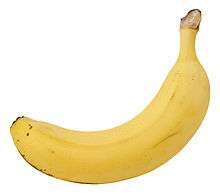Banana powder
Banana powder is a powder made from processed bananas. It is used as a component for production of milk shakes and baby foods.[1][2] It is also used in the manufacture of various types of cakes and biscuits.[3]
Manufacture
Banana powder is formed by using banana pulp, which is mechanically chopped and then processed with hydraulic shear using a colloid mill, turning it into a paste. Sodium metabisulfite is then used to brighten the yellow color of the paste. The paste is then dried by either spray- or drum-drying, although the latter is more common, because none of the paste is lost while drying. Drum-drying also produces about 2% more powder and dries it more thoroughly.[3][4] Regardless of the drying process, banana powder can generally only stay fresh on the shelf for about a year.[5]
History
The use of banana powder in baby formula has been widespread since the very early 1900s as a method of keeping babies healthy.[6] In 1916 it was also considered to be one of the "important industries of the West Indies" during this period, along with dried banana "figs".[7]
The United Fruit Company began to produce a product named Melzo during the 1930s, in which banana powder was the main ingredient. Because of the useful properties of banana powder, Melzo was marketed as a "health food for children and old folks, as a corrective for certain indigestions, and as a revitalizer for all who are sluggish mentally or physically".[2]
Usage
General uses
Banana powder has been found to be a "major source of carbohydrate and calories". While it is generally low as a source of protein, the beneficial ingredients of the powder are still "markedly superior to that of other fruits".[8] The powder has also been found to be useful as a general treatment for dyspepsia (indigestion).[9]
Scientific uses
In 1984, scientists from India were able to extract part of the "antiulcer compounds" found in banana powder, which ended up creating a type of powder that was "300 times more active" in preventing ulcers in the stomach.[10] Banana powder was later found to increase cell growth, which allowed more rapid healing of the area where ulcers had previously occurred.[11]
See also
References
- "The Hindu Business Line : BARC develops tech to make biscuits, baby food from banana". The Hindu. Retrieved 25 November 2010.
- Scofield Wilson, David (1999). Rooted in America: foodlore of popular fruits and vegetables. Univ. of Tennessee Press. pp. 28–29. ISBN 9781572330535. Retrieved 26 November 2010.
banana powder.
- H. Hui, Yiu; Stephanie Clark (2007). Handbook of Food Products Manufacturing: Principles, Bakery, Beverages, Cereals, Cheese, Confectionary, Fats, Fruits, and Functional Foods. Wiley-Interscience. p. 873. ISBN 9780470049648. Retrieved 26 November 2010.
- Food and Agriculture Organization of the United Nations (1989). Utilization of Tropical Foods: Trees. Food & Agriculture Org. pp. 33–34. ISBN 9789251027769. Retrieved 26 November 2010.
- Association of Food Technologists (2007). "Packaging and storage studies on spray dried ripe banana powder under ambient conditions". Journal of Food Science. 44: 16–19.
- Pamphlets on Biology: Kofoid collection, Volume 147. 1900. pp. 12–15. Retrieved 26 November 2010.
- United States. Bureau of Manufactures (1916). Commerce reports, Volume 4. Bureau of Foreign and Domestic Commerce, United States Dept. of Commerce. p. 290. Retrieved 26 November 2010.
- Sri Avinashilingam Home Science College (1976). The Indian journal of nutrition and dietetics, Volume 13. Sri Avinashilingam Home Science College for Women. pp. 218–224. Retrieved 26 November 2010.
- Al-Achi, Antoine (2008). An introduction to botanical medicines: history, science, uses, and dangers. ABC-CLIO. p. 80. ISBN 9780313350092. Retrieved 26 November 2010.
- Information, Reed Business (6 September 1984). "Rats with ulcers go bananas". New Scientist: 22.
- R.K. Goela; Saroj Guptab; R. Shankarc; A.K. Sanyal (1986). "Anti-ulcerogenic effect of banana powder (Musa sapientum var. paradisiaca) and its effect on mucosal resistance". Journal of Ethnopharmacology. 18 (1): 33–44. doi:10.1016/0378-8741(86)90041-3. PMID 3821133.
Further reading
- Wang, Juan; Li, Yuan Zhi; Chen, Ren Ren; Bao, Jin Yong; Yang, Gong Ming (January 2007). "Comparison of volatiles of banana powder dehydrated by vacuum belt drying, freeze-drying and air-drying". Food Chemistry. 104 (4): 1516. doi:10.1016/j.foodchem.2007.02.029.CS1 maint: ref=harv (link)
- von Meysenbug, L.; Fine, Archie (May 1936). "Banana powder and the fecal flora of infants". The Journal of Pediatrics. 8 (5): 630. doi:10.1016/S0022-3476(36)80163-2.CS1 maint: ref=harv (link)
